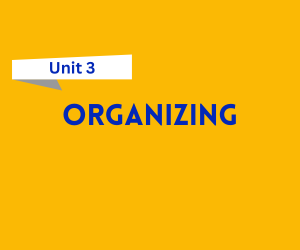Welcome to your go-to resource for Unit 3: Organizing and Organization Structure, part of the Principles of Management subject for BBA 1st Semester.
This unit introduces you to how businesses are structured internally, how work is divided, and how authority flows — all essential concepts for future managers and entrepreneurs.
Get ready to explore topics like departmentation, decentralization, formal vs. informal structures, and more — with free, unit-wise downloadable notes.

Download Unit 3 – Organizing & Organizational Structure Notes
Click below to download unit-wise notes in PDF format for quick revision and exam preparation:
⬇️
Download Unit 3 Notes PDF
These notes are simplified and aligned with top BBA university syllabi.
What is Organizing in Management?
Organizing is the second key function of management. After planning, managers need to arrange resources, tasks, and people to achieve the organization’s goals efficiently.
In this section, you’ll learn:
The meaning and purpose of organizing
How organizing supports coordination and clarity
Principles of organizing like unity of command, hierarchy, and division of work
Departmentation – Basis and Types
Departmentation is the process of dividing an organization into departments based on specific criteria. It’s important for creating a logical structure and promoting specialization.
You’ll explore:
Basis of departmentation: Function, product, geography, customer, process
Types of departments with real-world examples
Advantages and limitations of each type
Authority and Responsibility
A key part of organizing is defining who is responsible for what — and who holds the power to make decisions.
In this part of the unit, you’ll cover:
The meaning of authority and responsibility
Delegation: Assigning tasks and authority to subordinates
Decentralization: Distributing decision-making power across levels of management
Differences between delegation and decentralization
These concepts help improve efficiency, empowerment, and accountability in organizations.
Span of Control – Factors and Importance
Span of control refers to the number of subordinates a manager can effectively supervise.
In this section, you’ll understand:
What span of control is
Factors affecting span of control: complexity of tasks, competence of manager, nature of work
Why the right span of control leads to better communication and productivity
Formal and Informal Organization
Every company has both a formal structure (defined roles and rules) and an informal structure (personal relationships, social groups).
This part helps you explore:
The difference between formal and informal organizations
How informal networks can both support and hinder formal systems
Examples of informal influence in workplaces
Organization Structure – Types Explained
Organizational structure defines how activities like supervision, coordination, and task allocation are directed.
You’ll learn the key types of structures:
Line Organization – Simple, direct authority
Functional Organization – Division based on specialized functions
Line and Staff Organization – Combines expert staff advice with line authority
Matrix Structure – Dual reporting system; combines function and project-based teams
Understanding these types helps you analyze how companies manage complex operations.
